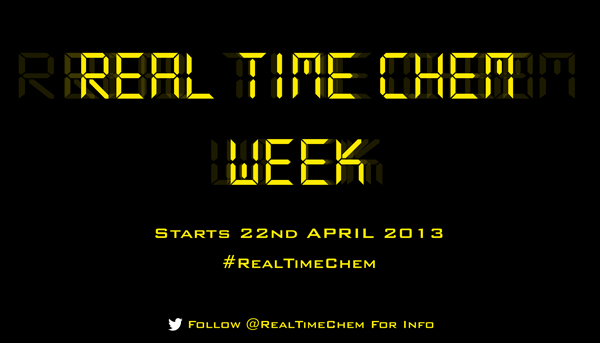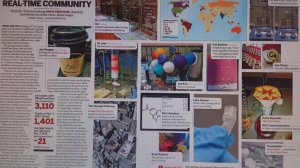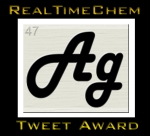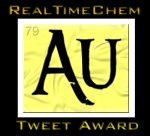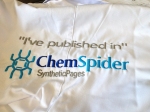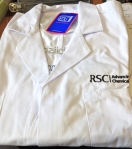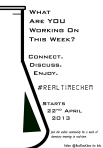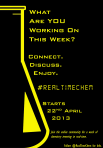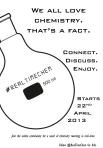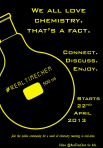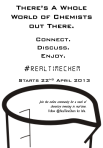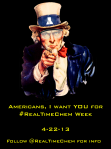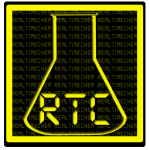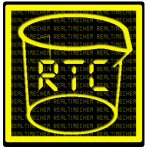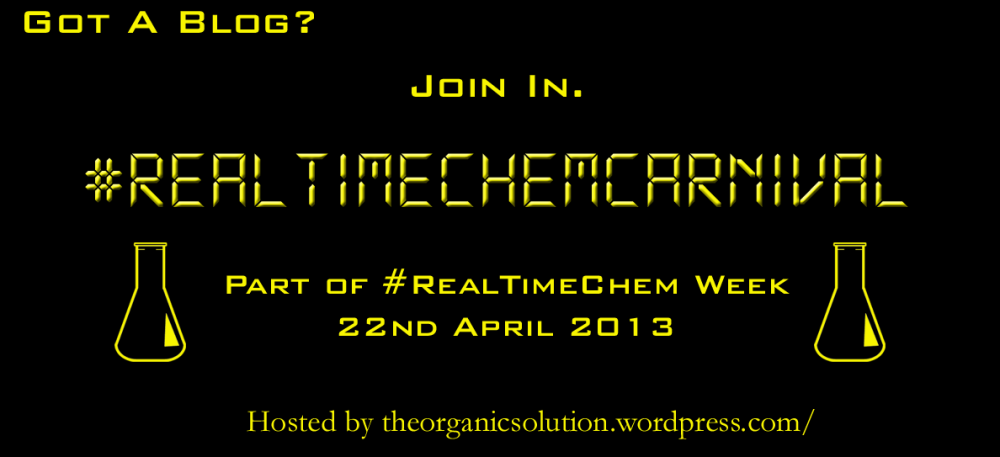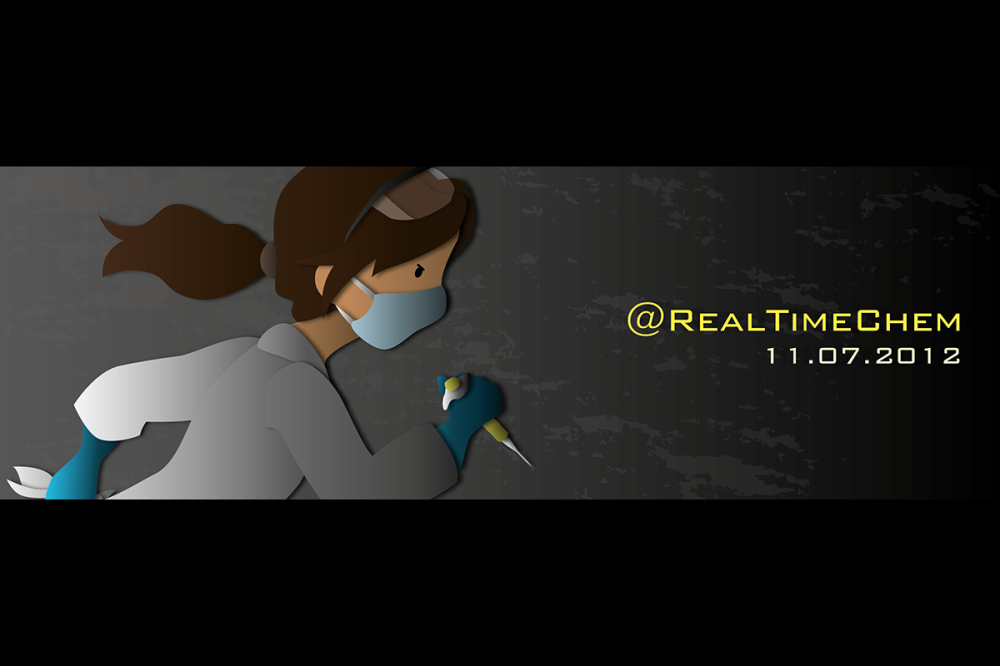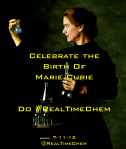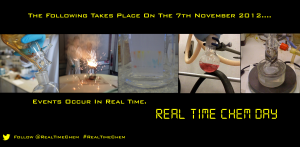
#RealTimeChem Week 2016 – FAQ

Hello everybody,
It’s almost that time again, time for #RealTimeChem Week! For those not in the know, #RealTimeChem Week is a 7 day event to help raise awareness of the #RealTimeChem chemistry community on Twitter and encourage as many chemists to tweet about their chemistry as possible. During the week various events, competitions and prizes are on offer, just to make it all the more fun and exciting.
If you are completely new and want to know more about #RealTimeChem in general, then following this link to the regular FAQ, where you can learn all about the project and the community.
If you don’t use #RealTimeChem all that regularly, this is the week to give it a go. Why not take some time during #RealTimeChem to share some chemistry and connect to other chemists in the world and have some fun while you’re at it?
When is it?
31st October-6th November. It runs all day for all 7 days.
How do I take part again?
Just tweet about chemistry using the hashtag #RealTimeChem. Simple as that.
So what’s going on during this year’s event?
This year has seen the proposed addition of four brand new elements to the periodic table: nihonium, moscovium, tennessine and oganesson (due to be ratified in November). And with these additions the periodic table is now full. Row 7 is done folks! Such a big change doesn’t happen all that often and it’s been just one of a number of big changes that have occurred, and not just in chemistry, in chemistry during 2016.
From a personal perspective, I became a father for the first time this year and while asking about the community for ideas for #RealTimeChem Week this year, a theme that resonated with me was a suggestion from @nadineborduas:
As such, this year’s overall event theme is “New Elements in Chemistry” i.e. #NewElemChem – but this is not just about the periodic table’s new additions, it’s all about you. What new elements have been introduced in your life as a chemist or to your chemistry this year? Perhaps you’ve just started your life as a chemist? Maybe you’ve made some new, ground breaking discoveries? Had to learn new skills? Got new equipment or glass ware? All the new things.
Of course the event isn’t limited to the theme, but this is just a few suggestions to think upon and will also be the subject of all #RealTimeChem Blog Carnival posts (more on that below).
#RealTimeChem Week Advert
Below you can find some banners to help you share the word about #RealTimeChem Week 2016. Designed again by the awesome Andy Brunning of @compoundinterest (www.compoundchem.com)

Plus in a few different colours:



#RealTimeChem Awards 2016 (31st October – 4th November)
Just like previous years, I will be offering awards for the best tweets during #RealTimeChem Week. The format has, again, changed a little due to circumstances and budget. This year, after noting that tweets are often quite slim on the weekend portion of #RealTimeChem week, I’ve decided to focus the awards on the 5 days of the working week, with The Great #RealTimeChem Cook off taking up the weekend slot.
So, all you have to do to potentially win a prize in the awards is tweet using #RealTimeChem on the Monday-Friday. There are three different awards available: Ag, Au and Pt. 10 awards will be given each of the five days (6 Ag, 3 Au, 1 Pt). Those winning the coveted Platinum award (5 total) will each win a prize, which is, as usual, a #RealTimeChem mug with this year’s snazzy logo emblazoned on it:

This years mug prize.
Sadly, due to severe budget restrictions this year, Gold and Silver award winners don’t get a prize unfortunately, except recognition that you are, completely awesome.
The Great #RealTimeChem Cook Off (5th– 6th November)
It’s back! Introduced last year, The Great #RealTimeChem Cook Off celebrates the perfect combination that is chemistry and cooking.
This year’s contest is sponsored by @WileyVCH‘s society chemistry journals.* Five winners will receive a ChemPubSoc Europe package containing
–A copy of What’s Cooking in Chemistry: How Leading Chemists Succeed in the Kitchen
-An exclusive #chemquackers scientist rubber duck (which you can use for all your #RealTimeChem posts!)
-Other Wiley-VCH goodies!

This year’s cook off prizes
The competition only takes place on the weekend of #RealTimeChem Week. Feel free to cook something during the week, but the tweet must be shared on the weekend of November 5th-6th to count.
All you have to do to enter the competition is to tweet your culinary creation (anything cooking, baking or food related) and include #RealTimeChem #whatscooking & @ChemPubSoc_Euro at the end of your tweet. Your tweet should include a picture or video of your creation and ideally have a short description (the description can even talk about the chemistry in your cooking! It’s up to you). Alternatively, you can write/link a recipe for others to try.
Everyone who tweets a cooking-related post using these hashtags will be entered into the competition, and 5 favourites will win a prize.
Hopefully with a bit more notice this time, you’ll all have time to get some ingredients in and post a tweet. I look forward to seeing what you all come up with!
—
*@ChemEurJ, @ChemistrySelect, @ChemistryOpen, @ChemBioChem, @ChemCatChem, @ChemMedChem, @ChemElectroChem, @ChemPhysChem, @ChemPlusChem, @ChemSusChem,@ChemPhotoChem, @EurJIC, and Eur. J. Org. Chem (all journals of @ChemPubSoc_Euro); @ChemAsianJ, @AsianJOrgChem, and @ChemNanoMat (all journals of the Asian Chemical Editorial Society); and @angew_chem (a journal of @GDCh_aktuell).
The #RealTimeChem Week Blog Carnival – #NewElemChem (31st October-6th November)

While the primary action for #RealTimeChem Week takes place on Twitter, there is also a blog carnival that runs alongside it. Chemistry bloggers are part of a thriving community and there are some excellent writers out there just waiting for readers.
Last year, #RealTimeChem Week had a “Back to the Future” theme, resulting in some fantastic posts on #OldTimeChem and #FutureTimeChem (highlights from last year are available here at SciTechConnect).
This year the theme is “New elements in chemistry” (#NewElemChem) and here’s the brief:
Write a blog post about the new chemistry in your life or the new life in your chemistry. The key is the “new” part. Our lives in chemistry are made up of many elements, both chemically and non-chemically speaking, and this is your chance to tell the community all about it. What new reactions have you run this year? Have you had fun with new chemicals? Did you learn something mind-bogglingly for the first time? Are you adapting to a new life situation that’s affecting your chemistry? Have you just started your life as a chemist? You can answer any of these questions and more. Write as little or as much as you like and share it during #RealTimeChem Week with #NewElemChem to be part of the blog carnival.
So, if you are a blogger, write a post and share it during the Week on Twitter using the hastag #NewElemChem. The carnival this year is being kindly hosted again by Elsevier’s SciTechConnect (thanks Katey Birtcher!). They will be looking out for this hashtag and will collect your blog post into a round up each day so they are all in one place for easy access.
Please note, if you don’t use the hashtag, then your post won’t be included in the carnival, so please make sure you remember to add it. I’ll also be retweeting these via @RealTimeChem to draw attention to them during the week. Happy writing!
Compound Interest competition
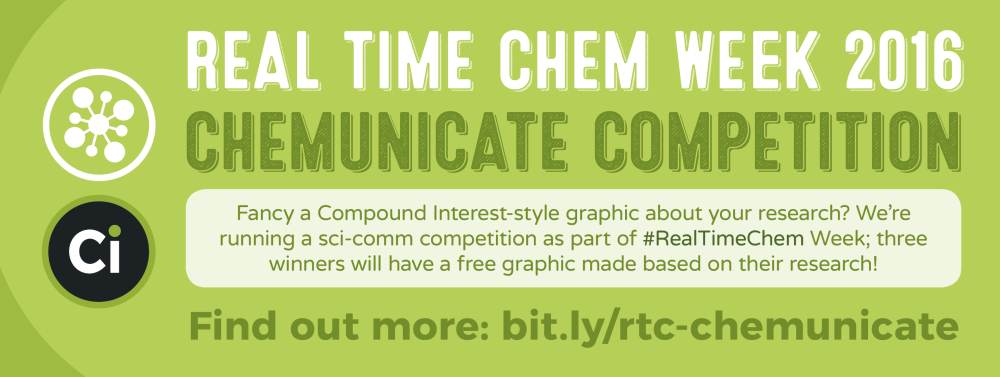
Want a graphic made based on your research? For this year’s #RealTimeChem Week, we’re once again after chemistry researchers who want to explain their research in easy-to-understand terms. To enter, all you have to do is write a piece no longer than 500 words, detailing your work and its potential applications. Note that it should be written so it’s understandable for an audience of non-scientists!
From the submitted pieces, three will be chosen to have graphics made based on them, and these graphics will then be featured alongside your written piece on the Compound Interest site during #RealTimeChem Week, which this year runs from 31 October until 6th November.
You can find details on how to enter here.
Other events/competitions
There is always room for more chemistry-based fun. If you would like to run an event or competition during #RealTimeChem Week or to sponsor one of the above events, then please get in touch with me via realtimechem@gmail.com and I’ll be happy to chat about the possibilities.
-Doctor Galactic-













